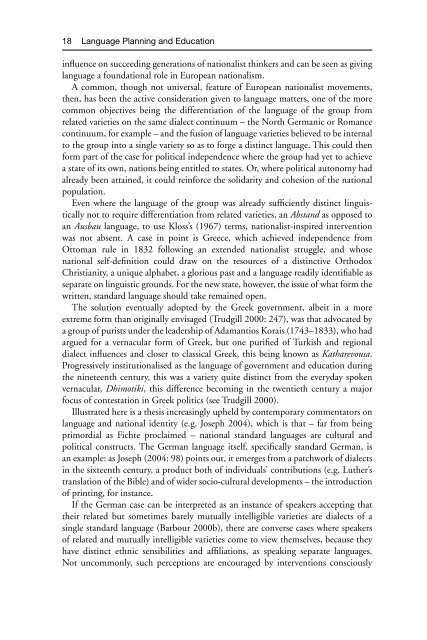Gibson Ferguson Language Planning and Education Edinburgh ...
Gibson Ferguson Language Planning and Education Edinburgh ...
Gibson Ferguson Language Planning and Education Edinburgh ...
You also want an ePaper? Increase the reach of your titles
YUMPU automatically turns print PDFs into web optimized ePapers that Google loves.
18 <strong>Language</strong> <strong>Planning</strong> <strong>and</strong> <strong>Education</strong><br />
influence on succeeding generations of nationalist thinkers <strong>and</strong> can be seen as giving<br />
language a foundational role in European nationalism.<br />
A common, though not universal, feature of European nationalist movements,<br />
then, has been the active consideration given to language matters, one of the more<br />
common objectives being the differentiation of the language of the group from<br />
related varieties on the same dialect continuum – the North Germanic or Romance<br />
continuum, for example – <strong>and</strong> the fusion of language varieties believed to be internal<br />
to the group into a single variety so as to forge a distinct language. This could then<br />
form part of the case for political independence where the group had yet to achieve<br />
a state of its own, nations being entitled to states. Or, where political autonomy had<br />
already been attained, it could reinforce the solidarity <strong>and</strong> cohesion of the national<br />
population.<br />
Even where the language of the group was already sufficiently distinct linguistically<br />
not to require differentiation from related varieties, an Abst<strong>and</strong> as opposed to<br />
an Ausbau language, to use Kloss’s (1967) terms, nationalist-inspired intervention<br />
was not absent. A case in point is Greece, which achieved independence from<br />
Ottoman rule in 1832 following an extended nationalist struggle, <strong>and</strong> whose<br />
national self-definition could draw on the resources of a distinctive Orthodox<br />
Christianity, a unique alphabet, a glorious past <strong>and</strong> a language readily identifiable as<br />
separate on linguistic grounds. For the new state, however, the issue of what form the<br />
written, st<strong>and</strong>ard language should take remained open.<br />
The solution eventually adopted by the Greek government, albeit in a more<br />
extreme form than originally envisaged (Trudgill 2000: 247), was that advocated by<br />
a group of purists under the leadership of Adamantios Korais (1743–1833), who had<br />
argued for a vernacular form of Greek, but one purified of Turkish <strong>and</strong> regional<br />
dialect influences <strong>and</strong> closer to classical Greek, this being known as Katharevousa.<br />
Progressively institutionalised as the language of government <strong>and</strong> education during<br />
the nineteenth century, this was a variety quite distinct from the everyday spoken<br />
vernacular, Dhimotiki, this difference becoming in the twentieth century a major<br />
focus of contestation in Greek politics (see Trudgill 2000).<br />
Illustrated here is a thesis increasingly upheld by contemporary commentators on<br />
language <strong>and</strong> national identity (e.g. Joseph 2004), which is that – far from being<br />
primordial as Fichte proclaimed – national st<strong>and</strong>ard languages are cultural <strong>and</strong><br />
political constructs. The German language itself, specifically st<strong>and</strong>ard German, is<br />
an example: as Joseph (2004: 98) points out, it emerges from a patchwork of dialects<br />
in the sixteenth century, a product both of individuals’ contributions (e.g. Luther’s<br />
translation of the Bible) <strong>and</strong> of wider socio-cultural developments – the introduction<br />
of printing, for instance.<br />
If the German case can be interpreted as an instance of speakers accepting that<br />
their related but sometimes barely mutually intelligible varieties are dialects of a<br />
single st<strong>and</strong>ard language (Barbour 2000b), there are converse cases where speakers<br />
of related <strong>and</strong> mutually intelligible varieties come to view themselves, because they<br />
have distinct ethnic sensibilities <strong>and</strong> affiliations, as speaking separate languages.<br />
Not uncommonly, such perceptions are encouraged by interventions consciously






